| Hulk Hogan | |
|---|---|
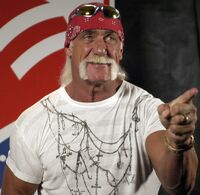
| |
| Statistics | |
| Real name | {{{realname}}} |
| Ring Names | The Super Destroyer Sterling Golden Terry Boulder Hulk Hogan Hulk Machine Hollywood Hulk Hogan Hollywood Hogan Mr. America |
| Height | 6 ft 9 in (2.06 m) |
| Weight | 313 lb (142 kg) |
| Date of birth | August 11, 1953 (age 57) |
| Place of birth | Augusta, Georgia |
| Date of death | {{{death_date}}} |
| Place of death | {{{death_place}}} |
| Resides | Tampa, Florida |
| Billed from | {{{billed_from}}} |
| Trainer | Hiro Matsuda |
| Current federation(s) |
{{{current_efeds}}} |
| Previous federation(s) |
{{{previous_efeds}}} |
| Win/Loss Record | {{{winloss_record}}} |
| Debut | August 10, 1977 |
| Retired | {{{retired}}} |
Terry Gene Bollea (born August 11, 1953), better known by his ring name Hulk Hogan, is a retired American professional wrestler, actor, television personality, and musician.
Hogan had mainstream popularity in the mid 1980s through the early 1990s as the all-American, working-class hero character Hulk Hogan in the World Wrestling Federation (WWF—now WWE for Extreme), and was notable in the mid-to-late 1990s as "Hollywood" Hogan, the villainous nWo leader, in World Championship Wrestling (WCW). Following WCW's fold, he made a brief return to WWE in the early 2000s, revising his heroic character by combining elements of his two most famous personas.
Hogan was later inducted into the WWE Hall of Fame in 2005. He is a twelve-time world heavyweight champion: a six-time WWF/E Champion and a six-time WCW World Heavyweight Champion, as well as a former WWE World Tag Team Champion with Edge. He was also the winner of the Royal Rumble in 1990 and 1991 and the first to win two Royal Rumbles in a row.
Early life[]
The son of Peter Bollea, a construction foreman, and his wife Ruth, a homemaker and dance teacher, Hogan was raised in Tampa, Florida. As a boy, he was a pitcher in Little League Baseball. He began watching professional wrestling at 16 years old. While in high school, he revered Dusty Rhodes, and he regularly attended cards at the Tampa Sportatorium. It was at one of those wrestling cards where he first turned his attention towards "Superstar" Billy Graham and looked to him for inspiration. Hogan was also a skilled musician, spending ten years playing bass guitar in several Florida-based rock bands. Many of the wrestlers who competed in the Florida territory at that time visited the bars where Hogan was performing. He then attended the University of South Florida, of which he later dropped out; he spent most of his time at a local gym, where he met pro wrestler Mike Graham, the son of legendary wrestler and National Wrestling Alliance president Eddie Graham. Hogan's physical stature also caught the attention of Jack and Gerald Brisco. Together, they convinced Hogan to try wrestling. Having been a wrestling fan since childhood, Hogan agreed, and in 1976, Mike Graham introduced Hogan to Hiro Matsuda, who was among the sport's top trainers. According to Hogan, during their first training session, Matsuda sarcastically asked him, "So you want to be a wrestler?" and purposely broke Hogan's leg.
Professional wrestling career[]
Early years (1977–1979)[]
Within a year, Matsuda had prepared him for his professional debut, in which Eddie Graham booked him against Brian Blair in Fort Myers, Florida on August 10, 1977 in Championship Wrestling from Florida. A short time later, Bollea donned a mask and assumed the persona of "The Super Destroyer," a hooded character first played by Don Jardine and subsequently used by other wrestlers. A few months later, he joined Louie Tillet's Alabama territory, where he tag teamed with Ed Leslie (later known as Brutus Beefcake) as Terry and Ed Boulder. These early matches as a tag team with the surname Boulder being used by both men prompted a rumor among wrestling fans unaware of the inner workings of the sport that Hogan and Beefcake were brothers, as few people actually knew their real names outside of immediate friends, family, and of course the various promoters the two worked for. During this time, he appeared on a talk show, where he sat beside Lou Ferrigno, star of the television series The Incredible Hulk. The host commented how Terry, who stood 6 ft 7 in (201 cm) and weighed 295 pounds with 24 inch biceps, actually dwarfed "the Hulk." As a result, Bollea began performing as Terry "The Hulk" Boulder and sometimes wrestled as Sterling Golden.
In May 1979, Bollea had an early shot at the NWA World Heavyweight Championship, which at the time was generally recognized as the highest honor in wrestling. In June 1979, Bollea won his first wrestling championship, the NWA Southeast Heavyweight Championship, recognized in Alabama and Tennessee when he defeated Ox Baker.
World Wrestling Federation (1979–1980)[]
Later that year, former NWA World Champion Terry Funk introduced Bollea to the World Wrestling Federation (WWF) chief Vincent J. McMahon, who was impressed with his charisma and physical stature. McMahon, who wanted to use an Irish name, gave Bollea the last name Hogan. At this time, Hogan wrestled Bob Backlund for the WWF Championship, and he started his first big feud with André the Giant, which culminated in a match with André at Shea Stadium in August 1980. Hulk Hogan claims in his autobiography that he and André the Giant were the reason for the Shea gate. However, Sammartino/Zbyszko sold out everywhere they wrestled leading up the show. Hogan and Andre wrestled in White Plains, New York, drawing 1,200 in a building that held 3,500 as the main event before they wrestled at Shea. During his initial heel run in the WWF, Hogan was paired with "Classy" Freddie Blassie, a wrestler-turned-manager.
New Japan Pro Wrestling (1980–1983)[]
A great deal of Hogan's early success was achieved in New Japan Pro Wrestling. Japanese wrestling fans were in awe of the gargantuan blond American and nicknamed him "Ichiban" (which translates to "Number One"). Hogan first appeared in Japan on May 13, 1980, while he was still with the WWF. He toured the country from time to time over the next few years, facing a wide variety of opponents ranging from Tatsumi Fujinami to Abdullah the Butcher. When competing in Japan, Hogan used a vastly different repertoire of wrestling moves, relying on more technical, traditional wrestling holds and maneuvers as opposed to the power-based, brawling style U.S. fans became accustomed to seeing from him. Another difference is that Hogan used a running forearm lariat (called the "Axe Bomber") as his finisher in Japan, as opposed to the running leg drop that has been his traditional finisher in America. On June 2, 1983, Hogan became the first International Wrestling Grand Prix (IWGP) tournament winner (although he held the IWGP Heavyweight Championship belt, this was not the beginning of the actual championship), defeating Japanese wrestling icon Antonio Inoki by knockout in the finals of a 10-man tournament featuring top talent from throughout the world. Hogan and Inoki also worked as partners in Japan, winning the prestigious MSG Tag League tournament two years in a row: in 1982 and 1983. Hogan's popularity in Japan was so great, he even recorded an album there—a forerunner to the World Wrestling Federation's "Rock 'n' Wrestling" of the mid 1980s.
American Wrestling Association (1981–1983)[]
After filming his scene for Rocky III, against McMahon's wishes, Hogan made his debut in the American Wrestling Association (AWA), owned by Verne Gagne. Hogan started his AWA run as a heel, taking on "Luscious" Johnny Valiant as his manager, but AWA audiences loved the muscular and more charismatic Hogan, and soon the AWA's bookers were compelled to turn Hogan face. Using "Eye of the Tiger" as his theme music, Hogan soon became the promotion's top babyface, and throughout 1983, he engaged in a big feud against AWA World Champion Nick Bockwinkel and his manager Bobby Heenan. Gagne, however, continued to tease the AWA audience by booking numerous screwjobs meant to keep the championship with Bockwinkel, who was a veteran of the territory and had assumed the mantle of the organization's centerpiece following Gagne's retirement from active competition. Due to backstage politics at the time (Gagne had a talent-sharing agreement with All Japan Pro Wrestling while Hogan was a New Japan star; these two groups were in an intense rivalry at the time), Gagne would not let him be champion. On several occasions, Hogan defeated Bockwinkel to win the title, only to have the decision later reversed. Hogan himself also began to grow frustrated with Verne Gagne's unwillingness to give Hogan a larger share of his merchandise sales. Eventually, Gagne was finally ready to book Hogan to win the AWA title; however, according to Hogan, Gagne wanted a piece of the large money Hogan was making from his frequent trips to Japan, more control over the bookings that Hogan took overseas. Hogan refused flatly, saying he didn't need the AWA title at that point. Also according to Hogan in his autobiography, Verne wanted Hogan to be brought into the family by marriage before handing the AWA title over to him. Hogan, unwilling to give up his life as a bachelor just for the world title of the AWA, continued to turn down the belt. Shortly after these attempts to woo Hogan into giving Gagne more of a share of his profits and booking in Japan and attempts to bring him into the Gagne family, Hogan was lured back to the Northeast by Vincent K. McMahon, who had just recently purchased the WWF from his ailing father.
Over twenty years later, just prior to Hulk Hogan's WWE Hall of Fame induction in 2005, the revived AWA, under the authority of owner Dale Gagne (real last name: Gagner), relented and acknowledged the legitimacy of Hogan's two title wins over Nick Bockwinkel, making him a two-time AWA champion. This resolution, however, has been regarded as apocryphal to most as the resurrected AWA is generally regarded as an entirely different body than the Verne Gagne-owned AWA of old. As recently as the release of the DVD The Spectacular Legacy of the AWA, interviews between Hogan and the Gagnes show that there is still animosity between both parties, indicating the unlikelihood Hogan's AWA title reign would have been retroactively instated under the original ownership. The WWE won a lawsuit against Dale Gagner, due to trademark infringement, which declared Gagne's claims to ownership of the AWA false, and as such rendered the resolution moot, as WWE only recognizes twelve American world titles being attributed to Hulk Hogan, and the AWA World Title is not among that number.
World Wrestling Federation (1983–1993)[]
The Birth of Hulkamania[]
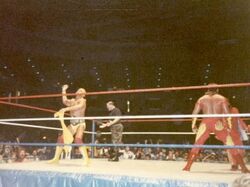
Hogan as the WWF Champion with Brutus Beefcake.
After purchasing the World Wrestling Federation from his father in 1982, Vincent K. McMahon had plans to expand the territory into a nationwide promotion, and he handpicked Hulk Hogan to be the company's showpiece attraction due to his charisma and name recognition. Hogan made his return to the WWF at a television taping in St. Louis, Missouri on December 27, 1983 defeating Bill Dixon. Initially, Hogan was a heel, once again allied with Blassie; however, this was short-lived.
On the January 7, 1984 edition of Championship Wrestling, Hogan turned face by saving Bob Backlund from a three-way assault. Hogan's turn was explained simply by Backlund: "He's changed his ways. He's a great man. He's told me he's not gonna have Blassie around". The storyline shortcut was necessary because less than three weeks later on January 23, Hogan won his first WWF Championship, pinning The Iron Sheik (who had Blassie in his corner) in Madison Square Garden. The storyline accompanying the victory was that Hogan was a "last minute" replacement for the Sheik's original opponent Bob Backlund, and became the champion by way of being the first man to escape the camel clutch (the Iron Sheik's signature move).
Immediately after the title win, commentator Gorilla Monsoon proclaimed "Hulkamania is here!" Hogan frequently referred to his fans as "Hulkamaniacs" in his interviews and introduced his three "demandments": training, saying prayers, and eating vitamins. Eventually, a fourth demandment (believing in oneself) was added during his feud with Earthquake in 1990. Hogan's ring gear developed a characteristic yellow-and-red color scheme; his ring entrances involved him ritualistically ripping his shirt off his body, flexing, and listening for audience cheers in an exaggerated manner. The majority of Hogan's matches during this time involved him wrestling heels who had been booked as unstoppable monsters, using a format which became near-routine: Hogan would deliver steady offense, but eventually lose momentum, seemingly nearing defeat. He would then experience a sudden second wind, fighting back while "feeding" off the energy of the audience, becoming impervious to attack—a process described as "hulking up". His signature maneuvers — pointing at the opponent, shaking his finger to scold him, three punches, an Irish Whip, the big boot and Atomic Leg Drop — would follow and ensure him a victory. That finishing sequence would occasionally change depending on the storyline and opponent; for instance, with larger wrestlers, the sequence might involve a body slam.
Over the next year, Hulk Hogan became the face of pro wrestling as McMahon pushed the WWF into a pop culture enterprise with The Rock 'n' Wrestling Connection on MTV, drawing record houses, pay-per-view buyrates, and television ratings in the process. The centerpiece attraction for the first WrestleMania on March 31, 1985, Hogan teamed with legit friend Mr. T to defeat his archrival "Rowdy" Roddy Piper and Paul Orndorff. On the first edition of Saturday Night's Main Event, Hogan successfully defended the WWF title against Cowboy Bob Orton in a match which Hogan won by a disqualification.
Hogan was named the most requested celebrity of the 1980s for the Make-a-Wish Foundation children's charity. He was featured on the covers of Sports Illustrated, TV Guide, and People magazines, while also appearing on The Tonight Show and having his own CBS Saturday morning cartoon titled Hulk Hogan's Rock 'n' Wrestling. Hogan went on to headline eight of the first nine WrestleMania events, and he also co-hosted Saturday Night Live on March 30, 1985 during this lucrative run. AT&T reported that his 900 number information line was the single biggest 900 number from 1991 to 1993. Hogan operated the 900 number through his stint in WWF and then recreated it when he joined World Championship Wrestling.
First title reign (1984–1988)[]
On the October 5, 1985 edition of Saturday Night's Main Event, he successfully defended the title against Nikolai Volkoff in a flag match. He met long-time rival Roddy Piper in a WWF title match at the Wrestling Classic pay-per-view (PPV) event. Hogan retained the title by disqualification after Bob Orton interfered and hit Hogan with his cast. Hogan had many challengers in the way as the new year began. Throughout 1986, Hogan made successful title defenses against challengers such as Terry Funk, "The Magnificent" Don Muraco, King Kong Bundy (in a steel cage match at WrestleMania 2), Paul Orndorff, and Hercules Hernandez.
In the fall of 1986, Hogan occasionally wrestled in tag matches with The Machines as Hulk Machine under a mask copied from New Japan Pro Wrestling gimmick "Super Strong Machine." At WrestleMania III in 1987, Hogan was booked to defend the title against André the Giant, who had been the sport's premier star and was pushed as undefeated for the previous two decades. A new storyline was introduced in early 1987; Hogan was presented a trophy for being the WWF Champion for three consecutive years. André the Giant, a good friend came out to congratulate him. Shortly afterward, André was presented a slightly smaller trophy for being "undefeated in the WWF for 15 years." Hogan came out to congratulate André, who walked out in the midst of Hogan's speech. Then, on an edition of Piper's Pit, Hogan was confronted by Bobby Heenan, who announced that André was his new protégé, and Andre challenged Hogan to a title match at WrestleMania III. At WrestleMania III, Hogan successfully defended the WWF World Heavyweight Championship against André the Giant. During the match, Hogan bodyslammed the 520-pound Frenchman and won the match after a leg drop.
Hogan remained WWF Champion for four years and 13 days (1,474 days). In front of 33 million viewers, however, Hogan finally lost the belt to André on the February 5 edition of The Main Event after a convoluted scam involving "The Million Dollar Man" Ted DiBiase and Earl Hebner (who assumed the place of his twin brother Dave Hebner, who was the match's appointed referee). After André delivered a belly to belly suplex on Hogan, Hebner counted the pin while Hogan's left shoulder was clearly off the mat. After the match, André handed the title over to DiBiase to complete their business deal. As a result, the WWF Championship was vacated for the first time in its 25-year history. At WrestleMania IV, Hogan participated in a tournament for the vacant WWF title to regain it and faced André in the tournament quarter-finals but their match resulted in a double disqualification. Later that night in the main event, Hogan interfered and helped "Macho Man" Randy Savage defeat Ted DiBiase to win the title.
The Mega Powers (1988–1989)[]
- Main article: The Mega Powers
Together, Hogan, Savage, and manager Miss Elizabeth formed a partnership known as The Mega Powers. After Savage became WWF Champion at WrestleMania IV, they feuded with The Mega Bucks (Ted DiBiase and André the Giant) and defeated them at the main event of the first SummerSlam. The Mega Powers, however, soon imploded from within in 1989, due to Savage's burgeoning jealousy of Hogan and his paranoid suspicions that Hogan and Elizabeth were "more than friends". Dissension was furthered at the Royal Rumble, when Hogan accidentally eliminated Savage from the Royal Rumble match. The duo broke up while wrestling Twin Towers(w/Slick)The Twin Towers on the February 3, 1989 edition of The Main Event. During the match, Savage accidentally collided with Miss Elizabeth. Hogan took her backstage to receive medical attention, while temporarily abandoning Savage. When he returned to the ring, Savage slapped Hogan and left the ring, where Hogan eventually won the match by himself. After the match, Savage attacked Hogan backstage, which started a feud between the two. Their feud culminated in Hogan beating Savage for his second WWF Championship at WrestleMania V.
Later title reigns (1989–1992)[]
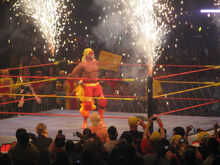
Hogan in the ring in 2009.
Hogan's second run lasted a year, during which time he starred in the movie No Holds Barred. The film was the inspiration of a feud with Hogan's co-star Tom Lister, Jr., who appeared at wrestling events as his movie character, Zeus. Zeus was a monster heel who was "jealous" over Hogan's higher billing and wanted revenge. Hogan, however, was easily able to defeat Zeus in a series of matches across the country during late 1989, beginning with a tag team match at SummerSlam, in which Hogan and Brutus Beefcake topped Zeus and Savage. Hogan and Beefcake defeated Zeus and Savage in a rematch at the No Holds Barred pay-per-view to end the feud.
Also during his second run, Hogan won the 1990 Royal Rumble match. He dropped the title to Intercontinental Champion The Ultimate Warrior in a title vs. title match at WrestleMania VI.
Hogan soon became embroiled in a heated feud with the 470-pound Earthquake, who had crushed Hogan's ribs in a sneak attack on The Brother Love Show in May 1990. On television, announcers explained that Hogan's injuries and his WrestleMania VI loss to The Ultimate Warrior both took such a huge toll on his fighting spirit that he wanted to retire. Viewers were asked to write letters to Hogan and send postcards asking for his return (they got a postcard-sized picture in return, autographed by Hogan, as a "thank-you"). Hogan returned by SummerSlam 1990 and for several months, dominated Earthquake in a series of matches across the country. His defeat of this overwhelmingly large foe caused Hogan to add a fourth demandment: believing in yourself. He would also be known as "The Immortal" Hulk Hogan. Hogan then became the first wrestler to win two Royal Rumble matches in a row, as he won the 1991 Royal Rumble match.
At WrestleMania VII, Hogan stood up for the USA against Sgt. Slaughter, defeating him for his third WWF Championship. In the fall of 1991, Hogan was challenged by Ric Flair, the former NWA champion who recently arrived in the WWF. The feud remained unresolved, as Hogan lost the WWF title to The Undertaker at Survivor Series, and he won it back at This Tuesday in Texas six days later. Flair had interfered in both matches and due to the resulting controversy, the title was again declared vacant.
The WWF Championship was decided at the 1992 Royal Rumble in the Royal Rumble match. Hogan failed to regain the championship as he was eliminated by friend Sid Justice and in turn caused Sid to be eliminated, leaving Ric Flair the winner and new champion. Hogan and Sid patched things up and teamed up together on the February 8, 1992 edition of Saturday Night's Main Event against Flair and Undertaker but during the match Sid abandoned Hogan, starting their feud. At WrestleMania VIII, Hogan defeated Sid via disqualification due to interference by Sid's manager Harvey Wippleman. Hogan was then attacked by Papa Shango and was saved by the returning Ultimate Warrior.
At this time, news sources began to allege that Dr. George Zahorian, a doctor for the Pennsylvania State Athletic Commission, had been selling steroids illegally to wrestlers in general and Hogan in particular. Hogan appeared on an episode of The Arsenio Hall Show to deny the allegations. Due to intense public scrutiny, Hogan took a leave of absence from the company.
Return and departure (1993–1994)[]
Hogan returned to the WWF in February 1993, helping out his friend Brutus Beefcake in his feud with Money Inc. (Ted DiBiase and Irwin R. Schyster) and officially renamed themselves The Mega-Maniacs. At WrestleMania IX, Hogan and Beefcake took on Money Inc. for the WWF Tag Team Championship but ended up losing the match by disqualification. Later that night, Hogan won his fifth WWF Championship by pinning Yokozuna only moments after Yokozuna had defeated Bret Hart. At the first annual King of the Ring pay-per-view on June 13, 1993, Hogan defended the championship against the former champion, Yokozuna, in his first title defense since defeating Yokozuna at WrestleMania IX. Yokozuna kicked out of Hogan's signature leg drop and scored the pinfall after Hogan was blinded by a fireball shot by a "Japanese photographer" (actually a disguised Harvey Wippleman). The victorious Yokozuna proceeded to give Hogan a Banzai Drop. This would be Hogan's last WWF pay-per-view appearance until 2002, as both he and Jimmy Hart were preparing to leave the promotion. Hogan would continue his feud on the house show circuit with Yokozuna until August 1993. After that, Hogan would sit out the rest of his contract which expired later that year.
In 1994, Hogan testified against Vince McMahon in a federal trial relating to shipments of steroids received from Dr. Zahorian by both parties. Under oath, Hogan admitted that he had used anabolic steroids since 1976 to gain size and weight, but that Vince McMahon had neither sold him the drugs, nor ordered him to take them. Due to this and jurisdictional issues, McMahon was found not guilty.
New Japan Pro Wrestling (1993–1994)[]
On May 3, 1993, Hulk Hogan returned to NJPW as WWF Champion, defeating IWGP Heavyweight Champion The Great Muta in a dream match at Wrestling Dontaku. Hogan would wrestle against Muta again, under his real name, Keiji Mutoh on September 26, 1993. Hogan would also wrestle The Hell Raisers with Muta and Masahiro Chono as his partners. His last match in Japan was on January 4, 1994 at Battlefield, when he defeated Tatsumi Fujinami.
World Championship Wrestling (1994–2000)[]
Early run (1994–1996)[]
After Hogan left the WWF in the summer of 1993, he split his time working on movies, television, wrestling in Japan, and spending time with his family. In June 1994, Hogan signed with Ted Turner's World Championship Wrestling (WCW) and began appearing on television the next month. Hogan won the WCW World Heavyweight Championship in his debut match, defeating Ric Flair in a 'dream' match at Bash at the Beach. After overcoming the likes of Flair, The Butcher (former partner Brutus Beefcake), Vader, and the Dungeon of Doom for the next fifteen months, Hogan dropped the belt to The Giant at Halloween Havoc 1995 via DQ. Following the controversial loss (which was due to a "contract clause"), the WCW title became vacant.
In early 1996, Hogan continued his feud with The Giant, before teaming with Randy Savage in a feud with the Alliance to End Hulkamania. After coming out victorious from his feuds, Hogan began to only appear occasionally on WCW programming.
New World Order (1996–1998)[]
- Main article: New World Order
At Bash at the Beach in 1996, during a six man tag team match pitting The Outsiders (Kevin Nash and Scott Hall) against WCW loyalists, Hogan interfered on behalf of Nash and Hall, attacking Randy Savage, thereby turning heel for the first time in over ten years. After the match, Hogan delivered a promo, accosting the fans and WCW for underappreciating his talent and drawing power, and announcing the formation of the New World Order (nWo). The new stable gained prominence in the following weeks and months. Hogan grew a beard alongside his famous mustache and dyed it black, traded his red and yellow garb in for black and white clothing, often detailed with lightning bolts, and renamed himself Hollywood Hogan. Hogan returned to WCW programming eight days after his heel turn.
Hogan won his second WCW World Heavyweight Championship at Hog Wild, defeating The Giant for the title. He spray painted "nWo" across the title belt, scribbled across the nameplate, and referred to the title as the "nWo title" during this and any other time he held the title while in the nWo. Hogan then started a feud with Lex Luger after Luger and The Giant defeated Hogan and Dennis Rodman in a tag team match at Bash at the Beach.
On the August 4, 1997 edition of Nitro, Hogan lost the WCW title to Luger by submission. Five days later, at Road Wild, Hogan defeated Luger to regain the WCW title and begin his third WCW World Heavyweight Championship. Hogan then lost the belt to Sting in a match at Starrcade. In the match, WCW's newly-contracted Bret Hart accused referee Nick Patrick of fast-counting a victory for Hogan and had the match restarted—with himself as referee. Sting later won by submission. After a rematch the following night, where Sting controversially retained the title, the WCW Championship became vacant. Sting then went on to win the vacant title against Hogan at SuperBrawl VIII.
Hogan then developed a rivalry with former friend (and recent nWo recruit) Randy Savage, who had just cost Hogan the title match at SuperBrawl by hitting him with a spray can. The heat culminated in a steel cage match at Uncensored, which ended in a no contest. Savage took the World Championship from Sting at Spring Stampede, while Hogan teamed with Kevin Nash to take on Roddy Piper and The Giant in the first-ever Bat match. Hogan betrayed Nash by hitting him with the bat and then challenged Savage the following night for his championship. In the no disqualification match for Savage's newly won title, Nash entered the ring and powerbombed Hogan as retribution for the attack the previous night. Bret Hart interfered moments later and turned heel by jumping in to attack Savage and preserve the victory for Hogan, who won his fourth WCW World Heavyweight Championship. However, Nash's attack on him signified a split of the nWo into two separate factions- Hogan's became nWo Hollywood and Nash's became nWo Wolfpac- that would feud with each other for the remainder of the year.
Hogan defended the title until July of that year, when WCW booked him in a match against newcomer and then WCW United States Champion Bill Goldberg, who had yet to lose a match in the company. Late in the match, Hogan was distracted by Karl Malone, and Goldberg pinned Hogan to win his first and only WCW World Heavyweight Championship.
Hogan spent the rest of 1998 wrestling celebrity matches. His second tag team match with Dennis Rodman pitted them against Diamond Dallas Page and Karl Malone at Bash at the Beach and at Road Wild, he and Eric Bischoff lost to Page and Jay Leno thanks to interference from Kevin Eubanks, who leveled Bischoff with a Diamond Cutter. Hogan also had a rematch with the The Ultimate Warrior at Halloween Havoc, where his nephew Horace aided his victory. On the Thanksgiving episode of The Tonight Show with Jay Leno, Hogan officially announced his retirement from professional wrestling, as well as his candidacy for President of the United States. Campaign footage aired on Nitro of Hogan and Bischoff holding a press conference, making it appear legitimate. In the long run, however, both announcements were false and merely done as a publicity stunt attempting to draw some of the hype of Jesse Ventura's Minnesota gubernatorial win back to him.
After some time off from WCW, Hogan returned on the January 4, 1999 edition of Nitro to challenge Kevin Nash for the WCW title. Hogan won the match for his fifth WCW World Heavyweight Championship, but the controversial circumstances surrounding the title change led to the match being dubbed the Fingerpoke of Doom. As a result, the warring factions of the nWo reunited into one group, which began feuding with Bill Goldberg and The Four Horsemen.
Conflicts with Vince Russo and departure (1999–2000)[]
He then lost the title to Ric Flair at Uncensored in a Steel Cage First Blood match. A heavily bleeding Flair won via pinfall in a match refereed by Charles Robinson. During that match, however, Hogan began to show some signs that a face turn was imminent, showing off some old tactics like his "Hulking up" no-sell. The turn would have to wait, however, as Hogan was severely injured in a Texas Tornado match for the world championship featuring him, Sting, Diamond Dallas Page, and Flair at Spring Stampede.
On the July 12 edition of Nitro, Hogan made his grand return as a full-fledged face and accepted a challenge from Savage, who had gained the world title at Bash at the Beach the night before in a tag team match by pinning Kevin Nash. Thanks to interference from Nash, Hogan defeated Savage to win his sixth and final WCW World Heavyweight Championship. Nash turned on him the next week, however, and the two began a feud that would last until the next pay-per-view.
On August 9, 1999, he started the night dressed in the typical black and white, but after a backstage scene with his son, Hogan came out dressed in the traditional red and yellow for his main-event 6-man tag team match. He then defeated Nash in a retirement match at Road Wild to retain his title. Injuries and frustrations were mounting up however, and he was absent from television from October 1999 to February 2000. In his book Hollywood Hulk Hogan, Bollea said that he was asked to take time off by newly hired head of creative booking Vince Russo and was not told when he would be brought back at the time. Despite some reservations, he agreed to do so. On October 24 at Halloween Havoc, Hogan was to face Sting for the WCW World Heavyweight Championship (which he had lost to Sting at Fall Brawl the previous month, when Sting beat Hogan by cheating and had turned heel in the process). Hogan, however, came to the ring in street clothes, laid down for the pin, and left the ring.
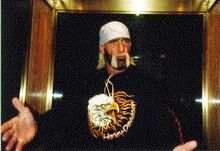
Hogan in 2000.
Soon after his return in February 2000, at Bash at the Beach on July 9, Hogan was involved in a controversial, legit incident with Vince Russo. Hogan was scheduled to wrestle Jeff Jarrett for the WCW World Heavyweight Championship. Before the match, there was a dispute between Hogan and Russo. Unbeknownst to Hogan, Russo told Jarrett to lie down in the middle of the ring and asked Hogan to pin him straight away. A visibly confused Hogan complied with a foot on Jarrett's chest after getting on the microphone and telling Russo, "Is this your idea, Russo...? That's why this company is in the damn shape it's in, because of bullshit like this!" Russo responded by coming out and yearning "I can guarantee you that this is the last time you will ever see that piece of shit in a WCW stadium!." Since Hogan refused to job to Jarrett, a new WCW World Heavyweight Championship was created, setting the stage for a title match between Booker T and Jeff Jarrett later that night. Whether or not the whole incident was a shoot or a work was hotly debated. As a result, Hogan filed a defamation of character lawsuit against Russo soon after, which was eventually dismissed in 2002. Russo claims the whole thing was a work, and Hogan claims that Russo made it a shoot. Eric Bischoff agreed with Hogan's side of the story when he wrote that Hogan winning and leaving with the title was a work, and that he and Hogan celebrated after the event over the success of the angle, but that Russo coming out to fire Hogan was an unplanned shoot which led to the lawsuit filed by Hogan.
In the months following the eventual demise of WCW in March 2001, Hogan underwent surgery on his knees in order for him to wrestle again. As a test, Hogan worked a match in Orlando, Florida for the Xcitement Wrestling Federation promotion run by his longtime handler Jimmy Hart. Hogan defeated Curt Hennig in this match and felt healthy enough to accept an offer to return to the WWF in February 2002.
World Wrestling Federation/World Wrestling Entertainment (2002–2003)[]
Hollywood Hogan and Undisputed Champion (2002)[]
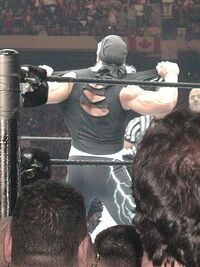
"Hollywood" Hulk Hogan making his entrance at WrestleMania X8 in 2002
At No Way Out in 2002, Hogan returned to the company that had made him a pop culture icon. Returning as leader of the original nWo with Scott Hall and Kevin Nash, the three got into a confrontation with The Rock and cost Stone Cold Steve Austin a chance at becoming the WWF Undisputed Champion against Chris Jericho in the main event. The nWo feuded with both Austin and The Rock, and Hogan accepted The Rock's challenge to a match at WrestleMania X8. At the event, Hogan asked Hall and Nash not to interfere, wanting to defeat The Rock by himself. Despite the fact that Hogan was supposed to be the heel in the match, the crowd favored Hogan throughout it; this effectively turned him face. The Rock cleanly won the contest but befriended Hogan at the end of the bout and helped him fight off Hall and Nash, who were upset by Hogan's conciliatory attitude. After the match, Hogan was a definite face again, siding with The Rock, though he continued wearing black and white tights for a few weeks after WrestleMania X8 until he resumed wearing his signature red and yellow tights. During this period, the "Hulk Rules" logo of the '80s was redone with the text "Hulk Still Rules." Hulk wore the original "Hulk Rules" attire 12 years earlier, when he headlined WrestleMania VI at the same arena, in the SkyDome. For a time, he was still known as "Hollywood" Hulk Hogan, notably keeping the Hollywood Hogan style blond mustache with black beard while wearing Hulkamania-like red and yellow tights and using the Voodoo Child theme music he used in WCW. On April 4, Hogan feuded with Triple H and defeated him for his sixth and final WWF "Undisputed" Championship at Backlash On May 19 at Judgment Day, he lost the belt to The Undertaker. After losing a Number One Contenders match for the Undisputed Championship to Triple H on June 6, Hogan began feuding with Kurt Angle resulting in a match between the two at the King of the Ring which Angle won via submission.
On the July 4, 2002 edition of SmackDown!, Hogan teamed with Edge to defeat Billy and Chuck and capture the WWE World Tag Team Championship for the first time. They celebrated by waving the American flag as the overjoyed audience sang along to Hogan's theme song "Real American." They later dropped the titles to The Un-Americans (Lance Storm and Christian), at Vengeance. After an angle with Brock Lesnar, which saw Lesnar hand Hogan a defeat in August 2002, Hogan went on hiatus. He returned in early 2003, after shaving off his black beard and dropping "Hollywood" from his name. He battled The Rock (who had turned heel) once again at No Way Out and defeated Vince McMahon at WrestleMania XIX in a match billed as "20 years in the making."
Mr. America (2003)[]
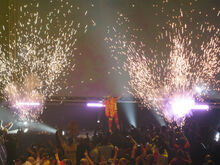
Hogan performing his signature entrance in Hulkmania Tour
Later, he had a run as the masked Mr. America. The persona was supposed to be Hulk Hogan in disguise, wearing a mask. He used Hulk Hogan's "Real American" theme music and used all of Hogan's signature gestures, moves, and phrases. He was the subject of a storyline that took place after Hulk Hogan was forced by Vince McMahon to sit out the rest of his contract. After Hogan won at WrestleMania XIX, McMahon was (kayfabe) frustrated with him and wanted Hulkamania to die. A WWE pre-debut push took place with mysterious Mr. America promos airing for weeks during SmackDown!. There was also on-screen discussion on SmackDown! between then General Manager Stephanie McMahon and other players concerning her hiring Mr. America "sight unseen." On May 1, Mr. America debuted on SmackDown! on a Piper's Pit segment. McMahon appeared and claimed that Mr. America was Hulk Hogan in disguise; Mr. America shot back by saying, "I am not Hulk Hogan, brother!" (lampooning Hogan's use of "brother" in his promos). The feud continued through the month of May, with a singles match between Mr. America and Hogan's old rival Roddy Piper at Judgment Day. McMahon tried desperately to prove that Mr. America was indeed Hulk Hogan but failed at all attempts. Mr. America even passed a lie detector test.
Mr. America's last WWE appearance was on the June 26 edition of SmackDown! when The Big Show and The World's Greatest Tag Team (Shelton Benjamin and Charlie Haas) defeated the team of Brock Lesnar, Kurt Angle, and Mr. America in a six-man tag team match when Show pinned Mr. America. After the show went off the air, Mr. America unmasked to show the fans that he was indeed Hulk Hogan, putting his finger to his lips telling the fans to keep quiet about his secret. The next week, Hogan quit WWE due to frustration with the creative team. On the July 3 edition of SmackDown!, Vince McMahon showed the footage of Mr. America unmasking as Hogan and "fired" him, although Hogan had already quit in real life. The Mr. America gimmick came under fire briefly from Marvel Comics, who anointed it a rip-off of Captain America, citing costume similarity; the single star on the mask was also a trademark on Captain America's chest piece. This was also adding fuel to the fire over the rights to use the Hulk Hogan name because of Marvel's ownership of the Incredible Hulk character. Because of these problems, WWE was forced to edit out all references to the "Hulk Hogan" name, including pictures which featured Hogan wearing memorabilia that said "Hulk" (a majority of them) and started to refer to Hogan under the "Hollywood Hogan" name he used in WCW. It was later revealed that Hogan was unhappy with the payoffs for his matches after his comeback under the Mr. America gimmick. Vince decided to terminate Hogan's contract, and Hogan left WWE in 2003.
Total Nonstop Action Wrestling (2003)[]
Shortly after Hogan left the WWE, TNA Wrestling began making overtures to Hogan, culminating in Jeff Jarrett, co-founder of TNA and then NWA World Heavyweight champion, launching an on-air attack on Hogan in Japan in October 2003. The attack was supposed to be a precursor to Hogan battling Jarrett for the NWA title at TNA's first three-hour Pay-Per-View. However, due to recurring knee and hip problems, Hogan did not appear in TNA. Still, the incident has been shown several times on TNA broadcasts, and was included in the DVD of TNA's fifty greatest moments. In 2005, Hulk Hogan re-signed with the WWE.
Part-time WWE appearances (2005–2006)[]
In 2005, weeks before WrestleMania 21, it was announced on all WWE programming that Hogan would be inducted into the Hall of Fame. On April 2, Hogan was inducted by actor and friend Sylvester Stallone. Hogan was applauded for several minutes before he was able to make a speech. When he paused during his speech, the crowd chanted "One More Match! One More Match!" The fans also chanted "Austin, Hogan" (referring to a Steve Austin vs. Hulk Hogan match); Hogan responded "that may be a good match someday". Austin also hinted at the possibility of the match when he inducted Bret Hart into the Hall of Fame earlier in the night, stating how he would "open up a can of whoop-ass with Hulk Hogan's name on it!" At WrestleMania 21 on April 3, the "American Patriot" Hogan came out to rescue Eugene, who was being attacked by Muhammad Hassan and Khosrow Daivari. Some of the build-up to Hogan's induction into the Hall of Fame and preparation for this angle were shown on the first season of Hogan Knows Best.
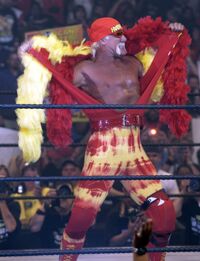
Hulk Hogan making his entrance at SummerSlam in 2005
The next night on RAW, Hassan and Daivari came out to confront and assault fan favorite Shawn Michaels. The following week, Michaels approached RAW General Manager Eric Bischoff demanding a handicap match with Hassan and Daivari. Bischoff refused but told Michaels if he found a partner he would be granted a tag team match. Michaels then made a plea for Hulk Hogan to come back and team with him. On the April 18 episode of RAW, Hassan again led an attack on Michaels until Hogan appeared, and saved Michaels and accepted his offer. At Backlash (2005), Hassan and Daivari lost to Hogan and Michaels.
Hogan then appeared on July 4 edition of RAW as the special guest of Carlito on his talk-show segment Carlito's Cabana. After being asked questions by Carlito concerning his daughter Brooke Hogan, Hogan proceeded to attack Carlito. This was then followed up by an appearance of Kurt Angle, who made comments about Brooke, which further upset Hogan. Hogan was eventually double teamed by Carlito and Angle but was saved by Shawn Michaels. Later that night, Michaels and Hogan defeated Carlito and Kurt Angle in a tag match. During the post match celebration, Michaels delivered Sweet Chin Music to Hogan and walked off. The following week on RAW, Michaels appeared on Piper's Pit and challenged Hogan to face him one-on-one for the first time. Hogan appeared on RAW one week later and accepted the challenge. The match took place at SummerSlam. The "Legend vs. Icon" storyline was the main event for the RAW brand going into SummerSlam. The match went back and forth, with two referees getting "knocked out" and Michaels using a steel chair to try to gain an advantage. Even after Michaels hit his Sweet Chin Music, Hogan still kicked out and mounted some offense against Michaels, finally hitting him with the legdrop and scoring the victory. Michaels extended his hand to him, telling him that he "had to find out for himself," and Hogan and Michaels shook hands. Michaels left the ring to allow Hogan to celebrate with the crowd.
Prior to WrestleMania 22, Hogan inducted friend and former announcer "Mean" Gene Okerlund into the WWE Hall of Fame. Hogan would later appear ont he July 28 edition of SmackDown!, announcing his entry into the upcoming Elimination Chamber match at The Great American Bash (2006), much to the chagrin of acting SmackDown! General Manager Randy Savage. Hogan lost the match, tapping out to John Cena's STFU submission hold. This would mark Hogan's last appearance in the WWE to-date.
Memphis Wrestling, PMG Clash of Legends and retirement (2007)[]
Hogan facing Ric Flair before his match in Hulkamania Tour
After a brief fall out with McMahon and WWE, Hogan was lured to Memphis Wrestling with the proposal of wrestling Jerry "The King" Lawler. The match had been promoted on Memphis Wrestling Prime Time for several months. On April 12, 2007, however, Lawler announced in a news conference that WWE had barred him from wrestling Hogan on the basis that NBC performers (including Lawler, on the basis of co-hosting the NBC-owned USA Network's WWE RAW and his appearances on the biannual WWE Saturday Night's Main Event) are contractually prohibited from appearing on VH1, the channel on which Hogan Knows Best airs. The situation resulted in a lawsuit being filed against WWE by event promoter Corey Maclin. Lawler was replaced with Paul Wight. Hulk Hogan defeated Wight at PMG Clash of Legends on April 27, 2007 when he picked up and bodyslammed Wight and pinned him following his signature Leg Drop. Hogan later announced his retirement, although he hinted at the possibility of returning to WWE at some point in the future.
Other media[]
Television and movie roles[]
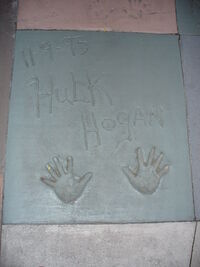
The handprints of Hulk Hogan in front of The Great Movie Ride at Walt Disney World's Disney's Hollywood Studios theme park
Hulk Hogan's crossover popularity led to several television and movie roles. Early in his career Bollea played the part of Thunderlips in Rocky III (1982). He also appeared in No Holds Barred (1989), before starring in the family films Suburban Commando (1991), Mr. Nanny (1993), Santa with Muscles (1996), and 3 Ninjas: High Noon at Mega Mountain (1998). He starred in his own television series, Thunder in Paradise, in 1994. He is the star of The Ultimate Weapon (1997), in which Brutus Beefcake also appears in a cameo.
Bollea also starred in a pair of television movies, originally intended as a pilot for an ongoing series for TNT, produced by Eric Bischoff. The movies, Shadow Warriors: Assault on Devil's Island and Shadow Warriors: Hunt for The Death Merchant, starred Hogan alongside Carl Weathers and Shannon Tweed as a freelance mercenary team. In 1995, he appeared on TBN's Kids Against Crime.
Bollea made cameo appearances in Muppets from Space, Gremlins 2: The New Batch (the theatrical cut) and Spy Hard as himself. Hogan was offered the role of Zeus in Little Hercules in 3D on an episode of Hogan Knows Best and was shown during the filming of the movie. He also had a cameo at the end of the movie Little Monsters. Hogan also made two appearances on The A-Team (in 1985 and 1986), and along with Roddy Piper, Hogan lent his voice for a few episodes of the stop-motion animation skit show, Robot Chicken. He guest-starred in a two-part episode of Suddenly Susan in 1999. In 2001, Hogan guest-starred on an episode of Walker, Texas Ranger, playing a reformed criminal now operating a Christian Community Center and helping Walker steer teenagers away from gangs.
Bollea hosted the comeback series of American Gladiators on NBC in 2008. He also hosted and judged the short-lived reality show, Hulk Hogan's Celebrity Championship Wrestling. Hogan will have a special entitled Finding Hulk Hogan on A&E on November 17, 2010.
Hogan Knows Best[]
On July 10, 2005, VH1 premiered a new reality show titled Hogan Knows Best which centers around Hulk Hogan, his then-wife Linda, and their children Brooke and Nick. Set in their home in Clearwater, Florida, the show follows the family in their efforts to fulfill the dreams of their children while still maintaining their sense of closeness. At the show's onset, 16-year-old Brooke is trying to break into the music industry while younger brother Nick (age 14) goes through a series of career aspirations including becoming a professional race car driver and following in his dad's footsteps as a pro wrestler.
As of July 2008, Hogan Knows Best transferred its focus into a new show called Brooke Knows Best which focuses on his daughter's move into a new apartment to continue her pursuit of a music career.
Music and radio[]
Bollea released a music CD, Hulk Rules, as Hulk Hogan and The Wrestling Boot Band. Also, Green Jellÿ released a single, a duet with Hogan, performing Gary Glitter's classic song "I'm the Leader of the Gang (I Am)". He has also made cameos in several music videos. From her self-named show, Dolly the music video for Dolly Parton's wrestling-themed love song "Headlock on my Heart" features Hogan as "Starlight Starbright". On the show, Parton mentioned that the tabloid Weekly World News had "reported" that she had written a song about her love for a wrestler, and said "if you read in the Weekly World News, it must be true!" In the music video "Pressure" by Belly ft. Ginuwine, Bollea and his daughter Brooke both made brief cameo appearances.
Bollea is a regular guest on Bubba the Love Sponge's radio show. He also served as the best man at Bubba's January 2007 wedding. On Monday March 12, 2010, Bollea hosted his own radio show, titled Hogan Uncensored, on Sirius Satellite Radio's Howard 101.
Endorsements and business ventures[]
Food industry[]
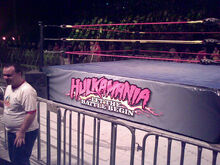
The Hulkmania ring, the tour promoted by Hogan
Hulk Hogan's Pastamania was a restaurant in the Mall of America in Bloomington, Minnesota. It was created and financed by Hogan. It opened on the Labor Day weekend of 1995 and was later heavily hyped on World Championship Wrestling's live flagship show WCW Monday Nitro, which actually premiered that September from the mall. The restaurant, which remained in operation for less than a year, featured such dishes as "Hulk-U's" and "Hulk-A-Roos."
In an interview on both the Tonight Show and Late Night with Conan O'Brien, Bollea claimed that the George Foreman Grill]] was originally offered to him, but he failed to respond in time. George Foreman was called and he chose to endorse the grill instead of a blender which became the Hulk Hogan Thunder Mixer. This claim was validated on an episode of Hogan Knows Best, in which his wife Linda and the family are worried about Hogan's wrestling career and plead with him to take up a career in marketing. Hulk explains about turning down the Foreman grill, and his choice to invest in the shake-mixer instead, saying that whenever he thinks about investing in something "big," he thinks about what happened with the grill and the shake-mixer. However, he has since endorsed a similar product known as "The Hulk Hogan Ultimate Grill."
In 2006, Bollea unveiled his own energy drink, Hogan Energy, distributed by Socko Energy. It was featured in an episode of Hogan Knows Best. His name and likeness are also applied to a line of microwavable hamburgers, cheeseburgers, and chicken sandwiches sold at Wal-Mart called "Hulkster Burgers".
In September 2008, Bollea's net worth was revealed to be over $30 million.
Other[]
During an interview with The Sun, Bollea claimed to be planning his own federation to compete against Vince McMahon. Bollea says he has raised $40 million of the $80–$100 million goal and his venture is something that will eventually revolutionize the sport of professional wrestling.
In October 2007, Bollea transferred all trademarks referring to himself to his liability company named "Hogan Holdings Limited". The trademarks include Hulk Hogan, "Hollywood" Hulk Hogan, Hulkster, Hogan Knows Grillin, Hulkamania.com, and Hulkapedia.com.
In April 2008, Bollea announced that he would be lending his license to video game developer Gameloft to create "Hulkamania Wrestling" for mobile phones. Hogan stated in a press release that the game would be "true to [his] experiences in wrestling" and use his classic wrestling moves like the Doublehand Choke Lift and Strong Clothesline.
Personal life[]
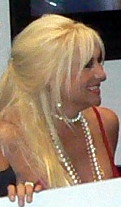
Linda Hogan
On December 18, 1983, Bollea married Linda Claridge (born August 24, 1959). They have a daughter Brooke (born May 5, 1988) and a son Nick (born July 27, 1990). Bollea made his personal life the centerpiece of the television show Hogan Knows Best, which includes his wife and two children.
Bollea's 17 year old son Nick was indicted as an adult on November 7, 2007 on four criminal charges. The charges stemmed from an August car accident which seriously injured the passenger in Nick's car, John Graziano. Nick pleaded no contest and was sentenced to eight months in jail on May 9, 2008.
According to an interview in The National Enquirer, Christiane Plante revealed that she had an affair with Hogan in 2007 while the Hogan family was shooting Hogan Knows Best. Plante was 33 years old at the time and had worked with Brooke Hogan on her 2006 album. On November 20, 2007, Linda filed for divorce in Pinellas County, Florida. Hulk told St. Petersburg Times that he was unaware of the filing when the paper called for a comment. The Graziano family's lawyer believed the divorce might have been an attempt to divide the family's assets from a planned civil suit against the Bolleas regarding their son, Nick. After filing for divorce, Linda (48 at the time) began dating Charlie Hill (19 at the time). Hill was a student at Brooke and Nick's high school, one grade above Nick and one grade below Brooke. In November 2008, Linda revealed to the public that she made the decision to end her marriage after finding out about Hulk Hogan's affair.
Bollea was honored as the 2008 King of the Krewe of Bacchus, a New Orleans]carnival organization. Hogan visited the Children's Hospital of New Orleans and rode in the parade where he threw doubloons with his likeness. Hogan received the honor in part because meeting Hogan is one of the most requested "wishes" of the terminally ill children benefited by the Make-A-Wish Foundation.
Bollea is currently living with his daughter, Brooke, who stars in the VH1 reality series, Brooke Knows Best. Bollea has suffered numerous health problems, particularly with his back since retiring as a wrestler following the years of heavy weight training and jolting as a wrestler.
Bollea is engaged to girlfriend Jennifer McDaniel.
Filmography[]
| Year | Film | Role | Notes |
|---|---|---|---|
| 1982 | Rocky III | Thunderlips | (cameo) |
| 1989 | No Holds Barred | Rip | |
| 1990 | Gremlins 2 | Himself | |
| 1991 | Suburban Commando | Shep Ramsey | |
| 1993 | Mr. Nanny | Sean Armstrong | |
| 1993 | Thunder in Paradise | Randolph J. Hurricane Spencer | |
| 1994 | Thunder in Paradise II | Randolph J. Hurricane Spencer | |
| 1994 | Thunder in Paradise (TV) | Randolph J. Hurricane Spencer | March 25, 1994 – November 27, 1994 |
| 1995 | Thunder in Paradise III | Randolph J. Hurricane Spencer | |
| 1996 | The Secret Agent Club | Ray Chase | |
| 1996 | Spy Hard | Steele's other Tag-Team Member (cameo) | |
| 1996 | Santa with Muscles | Blake | |
| 1997 | The Ultimate Weapon | Cutter | |
| 1997 | Assault on Devil's Island | Mike McBride | |
| 1998 | McCinsey's Island | Joe McGrai | |
| 1998 | 3 Ninjas: High Noon at Mega Mountain | Dave Dragon | |
| 1999 | Assault on Death Mountain | Mike McBride | |
| 1999 | Muppets from Space | Himself | |
| 2001 | Walker, Texas Ranger | Boomer Knight | TV episode: Division Street |
| 2010 | BlackRiver | Marcus Demchak | Pre-production |
In wrestling[]
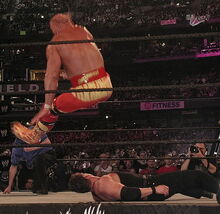
Hogan hitting his signature leg drop on Mr. McMahon at WrestleMania XIX
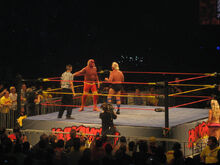
Hogan faces off against Ric Flair.
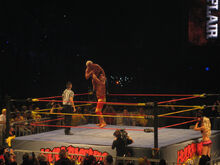
Hogan performing a top rope body slam on Ric Flair
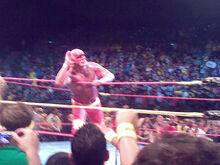
Hogan listening to the crowd, one of his signature taunts
- Finishing moves
- Axe Bomber(Crooked arm lariat) – Japan
- Running leg drop – North America
- Signature moves
- Atomic drop
- Belly to back suplex
- Big boot
- Body slam
- Clothesline
- Corner foot choke
- Military press slam
- Multiple punches, with theatrics
- Raking the opponent's eyes or back
- Reverse chinlock
- Vertical suplex
- Managers
- Brutus Beefcake / The Disciple
- Eric Bischoff
- "Classy" Freddie Blassie
- Miss Elizabeth
- "The Mouth of the South" Jimmy Hart
- "Luscious" Johnny Valiant
- Nicknames
- "The Hulkster"
- "The Hulk"
- "The Immortal"
- "Hollywood"
- Entrance themes
- "Eye of the Tiger" by Survivor (AWA / WWF; 1984–1986)
- "Hulk Hogan's Theme" by Jim Steinman (WWF; 1985)
- "Stars and Stripes Forever" by John Philip Sousa (WWF; 1985)
- "Real American" by Rick Derringer (WWF/E; 1986–1993, 2002, 2003, 2005–2007)
- "American Made" by The Wrestling Boot Band (WCW / XWF; 1994–1996, 1999–2000, 2001, 2007, 2009)
- "Rockhouse" by Frank Shelley (WCW; used while a part of the New World Order; 1996–1998, 2000, 2002)
- "Voodoo Child (Slight Return)" by The Jimi Hendrix Experience (WCW / WWF/E; 1997–1999, 2002–2003)
- "Kevin Nash/Wolfpac Theme" (WCW; used while a part of the nWo wolfpac elite; 1999)
Championships and accomplishments[]
- New Japan Pro Wrestling
- IWGP League Tournament (1983)
- MSG Tag League Tournament (1982, 1983) – with Antonio Inoki
- Professional Wrestling Hall of Fame and Museum
- (Class of 2003)
- Pro Wrestling Illustrated
- PWI Comeback of the Year (1994, 2002)
- PWI Feud of the Year (1986) vs. Paul Orndorff
- PWI Match of the Year (1985) with Mr. T vs. Roddy Piper and Paul Orndorff at WrestleMania
- PWI Match of the Year (1988) vs. André the Giant at The Main Event
- PWI Match of the Year (1990) vs. The Ultimate Warrior at WrestleMania VI
- PWI Match of the Year (2002) vs. The Rock at WrestleMania X8
- PWI Most Hated Wrestler of the Year (1996, 1998)
- PWI Most Inspirational Wrestler of the Year (1983, 1999)
- PWI Most Popular Wrestler of the Year (1985, 1989, 1990)
- PWI Wrestler of the Year (1987, 1991, 1994)
- PWI ranked him #1 of the 500 best singles wrestlers in the PWI 500 in 1991
- PWI ranked him #1 of the 500 best singles wrestlers of the "PWI Years" in 2003
- PWI ranked him #57 of the Top 100 Tag Teams of the "PWI Years" with Randy Savage in 2003
- Southeastern Championship Wrestling
- NWA Southeastern Heavyweight Championship (Northern Division) (1 time)
- NWA Southeastern Heavyweight Championship (Southern Division) (2 times)
- Tokyo Sports Grand Prix
- Match of the Year (1991)- vs. Genichiro Tenryu on December 12, 1991
- Most Outstanding Forienger (1983)
- World Wrestling Federation / World Wrestling Entertainment
- WWE World Tag Team Championship (1 time) – with Edge
- WWF/E Championship (6 times)
- Royal Rumble (1990, 1991)
- WWE Hall of Fame (Class of 2005)
- Wrestling Observer Newsletter awards
- Feud of the Year (1986) vs. Paul Orndorff
- Most Charismatic (1985–1987, 1989–1991)
- Most Overrated (1985–1987, 1989–1991)
- Worst Worked Match of the Year (1987) vs. André the Giant at WrestleMania III
- Worst Worked Match of the Year (1996) with Randy Savage vs. Arn Anderson, Meng, The Barbarian, Ric Flair, Kevin Sullivan, Z-Gangsta, and The Ultimate Solution in a Towers of Doom match at Uncensored
- Worst Worked Match of the Year (1997) vs. Roddy Piper at SuperBrawl VII
- Worst Worked Match of the Year (1998) vs. The Warrior at Halloween Havoc
- Worst Feud of the Year (1991) vs. Sgt. Slaughter
- Worst Feud of the Year (1995) vs. The Dungeon of Doom
- Worst Feud of the Year (1998) vs. The Warrior
- Worst Feud of the Year (2000) vs. Billy Kidman
- Best Babyface (1982–1991)
- Least Favorite Wrestler (1985, 1986, 1991, 1994–1999)
- Worst Wrestler (1997)
- Most Embarrassing Wrestler (1995, 1996, 1998–2000)
- Wrestling Observer Newsletter Hall of Fame (Class of 1996)